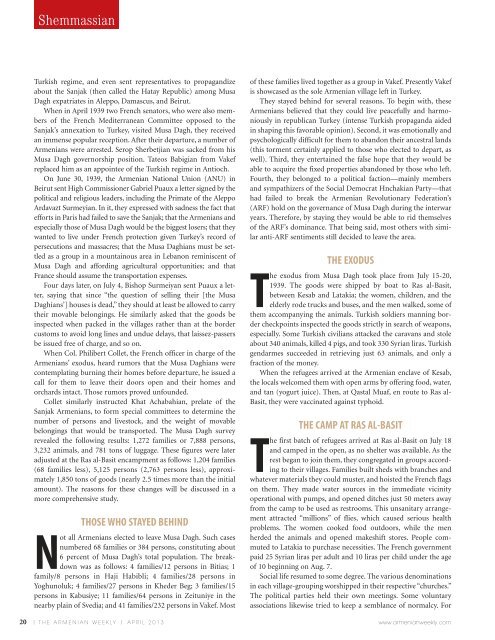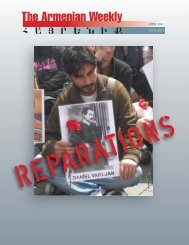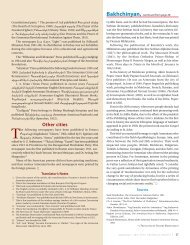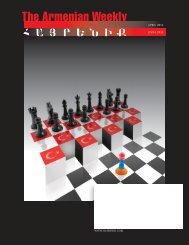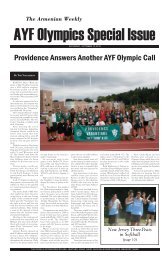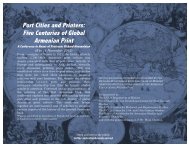Create successful ePaper yourself
Turn your PDF publications into a flip-book with our unique Google optimized e-Paper software.
Shemmassian<br />
Turkish regime, and even sent representatives to propagandize<br />
about the Sanjak (then called the Hatay Republic) among Musa<br />
Dagh expatriates in Aleppo, Damascus, and Beirut.<br />
When in April 1939 two French senators, who were also members<br />
of the French Mediterranean Committee opposed to the<br />
Sanjak’s annexation to Turkey, visited Musa Dagh, they received<br />
an immense popular reception. After their departure, a number of<br />
<strong>Armenian</strong>s were arrested. Serop Sherbetjian was sacked from his<br />
Musa Dagh governorship position. Tateos Babigian from Vakef<br />
replaced him as an appointee of the Turkish regime in Antioch.<br />
On June 30, 1939, the <strong>Armenian</strong> National Union (ANU) in<br />
Beirut sent High Commissioner Gabriel Puaux a letter signed by the<br />
political and religious leaders, including the Primate of the Aleppo<br />
Ardavazt Surmeyian. In it, they expressed with sadness the fact that<br />
efforts in Paris had failed to save the Sanjak; that the <strong>Armenian</strong>s and<br />
especially those of Musa Dagh would be the biggest losers; that they<br />
wanted to live under French protection given Turkey’s record of<br />
persecutions and massacres; that the Musa Daghians must be settled<br />
as a group in a mountainous area in Lebanon reminiscent of<br />
Musa Dagh and affording agricultural opportunities; and that<br />
France should assume the transportation expenses.<br />
Four days later, on July 4, Bishop Surmeiyan sent Puaux a letter,<br />
saying that since “the question of selling their [the Musa<br />
Daghians’] houses is dead,” they should at least be allowed to carry<br />
their movable belongings. He similarly asked that the goods be<br />
inspected when packed in the villages rather than at the border<br />
customs to avoid long lines and undue delays, that laissez-passers<br />
be issued free of charge, and so on.<br />
When Col. Philibert Collet, the French officer in charge of the<br />
<strong>Armenian</strong>s’ exodus, heard rumors that the Musa Daghians were<br />
contemplating burning their homes before departure, he issued a<br />
call for them to leave their doors open and their homes and<br />
orchards intact. Those rumors proved unfounded.<br />
Collet similarly instructed Khat Achabahian, prelate of the<br />
Sanjak <strong>Armenian</strong>s, to form special committees to determine the<br />
number of persons and livestock, and the weight of movable<br />
belongings that would be transported. The Musa Dagh survey<br />
revealed the following results: 1,272 families or 7,888 persons,<br />
3,232 animals, and 781 tons of luggage. These figures were later<br />
adjusted at the Ras al-Basit encampment as follows: 1,204 families<br />
(68 families less), 5,125 persons (2,763 persons less), approximately<br />
1,850 tons of goods (nearly 2.5 times more than the initial<br />
amount). The reasons for these changes will be discussed in a<br />
more comprehensive study.<br />
THOSE WHO STAYED BEHIND<br />
Not all <strong>Armenian</strong>s elected to leave Musa Dagh. Such cases<br />
numbered 68 families or 384 persons, constituting about<br />
6 percent of Musa Dagh’s total population. The breakdown<br />
was as follows: 4 families/12 persons in Bitias; 1<br />
family/8 persons in Haji Habibli; 4 families/28 persons in<br />
Yoghunoluk; 4 families/27 persons in Kheder Beg; 3 families/15<br />
persons in Kabusiye; 11 families/64 persons in Zeituniye in the<br />
nearby plain of Svedia; and 41 families/232 persons in Vakef. Most<br />
of these families lived together as a group in Vakef. Presently Vakef<br />
is showcased as the sole <strong>Armenian</strong> village left in Turkey.<br />
They stayed behind for several reasons. To begin with, these<br />
<strong>Armenian</strong>s believed that they could live peacefully and harmoniously<br />
in republican Turkey (intense Turkish propaganda aided<br />
in shaping this favorable opinion). Second, it was emotionally and<br />
psychologically difficult for them to abandon their ancestral lands<br />
(this torment certainly applied to those who elected to depart, as<br />
well). Third, they entertained the false hope that they would be<br />
able to acquire the fixed properties abandoned by those who left.<br />
Fourth, they belonged to a political faction—mainly members<br />
and sympathizers of the Social Democrat Hnchakian Party—that<br />
had failed to break the <strong>Armenian</strong> Revolutionary Federation’s<br />
(ARF) hold on the governance of Musa Dagh during the interwar<br />
years. T<strong>here</strong>fore, by staying they would be able to rid themselves<br />
of the ARF’s dominance. That being said, most others with similar<br />
anti-ARF sentiments still decided to leave the area.<br />
THE EXODUS<br />
The exodus from Musa Dagh took place from July 15-20,<br />
1939. The goods were shipped by boat to Ras al-Basit,<br />
between Kesab and Latakia; the women, children, and the<br />
elderly rode trucks and buses, and the men walked, some of<br />
them accompanying the animals. Turkish soldiers manning border<br />
checkpoints inspected the goods strictly in search of weapons,<br />
especially. Some Turkish civilians attacked the caravans and stole<br />
about 340 animals, killed 4 pigs, and took 330 Syrian liras. Turkish<br />
gendarmes succeeded in retrieving just 63 animals, and only a<br />
fraction of the money.<br />
When the refugees arrived at the <strong>Armenian</strong> enclave of Kesab,<br />
the locals welcomed them with open arms by offering food, water,<br />
and tan (yogurt juice). Then, at Qastal Muaf, en route to Ras al-<br />
Basit, they were vaccinated against typhoid.<br />
THE CAMP AT RAS AL-BASIT<br />
The first batch of refugees arrived at Ras al-Basit on July 18<br />
and camped in the open, as no shelter was available. As the<br />
rest began to join them, they congregated in groups according<br />
to their villages. Families built sheds with branches and<br />
whatever materials they could muster, and hoisted the French flags<br />
on them. They made water sources in the immediate vicinity<br />
operational with pumps, and opened ditches just 50 meters away<br />
from the camp to be used as restrooms. This unsanitary arrangement<br />
attracted “millions” of flies, which caused serious health<br />
problems. The women cooked food outdoors, while the men<br />
herded the animals and opened makeshift stores. People commuted<br />
to Latakia to purchase necessities. The French government<br />
paid 25 Syrian liras per adult and 10 liras per child under the age<br />
of 10 beginning on Aug. 7.<br />
Social life resumed to some degree. The various denominations<br />
in each village-grouping worshipped in their respective “churches.”<br />
The political parties held their own meetings. Some voluntary<br />
associations likewise tried to keep a semblance of normalcy. For<br />
20 | THE ARMENIAN WEEKLY | APRIL 2013<br />
www.armenianweekly.com


